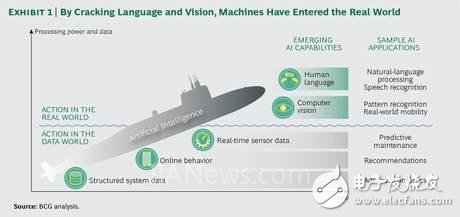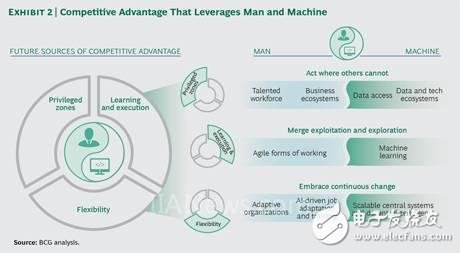Artificial intelligence is a new technology science that researches and develops theories, methods, techniques and application systems for simulating, extending and extending human intelligence. In the future, all governments, companies, and military are artificial intelligence organizations, and artificial intelligence will be everywhere. This paper interprets the connotation and application of artificial intelligence, focuses on the impact of artificial intelligence on the reshaping of competitive advantage, and summarizes the winning strategy of enterprises in the era of artificial intelligence.
What will artificial intelligence do?Artificial intelligence enables rapid processing of learning, decision-making, and action, with both "fast processing" and "self-learning" capabilities. Therefore, we can compare it to people. The difference is that humans are better at parallel processing (pattern recognition), but weaker in sequential processing (logical reasoning); while computers are less involved in parallel processing and are extremely fast in sequential processing.
Artificial intelligence machines can talk, read, absorb, and store encyclopedic knowledge, and intuitively and naturally engage in deep dialogue with people on a relatively broad topic.
Artificial intelligence machines can identify objects, optical patterns, and leave the virtual world to the real world.

Figure 1 The machine leaves the virtual world by mastering the language and perspective
Artificial intelligence has become a basic technology in many fields such as driverless cars and financial trade. Even self-study arithmetic has embedded conventional mobile and network services. Researchers improve the performance of artificial intelligence by processing data derived from digital devices and sensors, and the machine also captures the specific language and perspectives of everyday human communication. For example, artificial intelligence projects have more accurately detected the precise location of cancer cells than radiologists. In the future, artificial intelligence will also develop toward more advanced and strong artificial intelligence. The so-called strong artificial intelligence is a significant breakthrough in technology, applications are expanding, and various complex problems can be solved. At present, many traditional fields such as finance, retail, and medical care have begun to invest heavily in the field of artificial intelligence.
For enterprises, artificial intelligence is no longer an optional part. It is crucial for how to exert the strengths of people and computers and create competitive advantages.
Artificial intelligence leads to innovation in competitive advantageEarlier, a technical tool could be an advantage, such as Wal-Mart's logistics tracking system in the 1980s. Now, with artificial intelligence, the competitive advantage of enterprises will be transformed into algorithms and data assets. Through the establishment of learning networks and data ecology, consumers will be fully informed and data-driven for immediate and automatic decision-making. “Open Artificial Intelligence†is a non-profit organization initiated by Elon Musk to make the use of artificial intelligence tools and research results more widely.
Unlike traditional methods of gaining competitive advantage through resources and performance, artificial intelligence will rebuild its advantages (see Figure 2). For example, artificial intelligence can help companies win market share, including patents, distribution networks, user channels, and scale-up.

Figure 2 Competitive advantage built using people and machines
Let's take data as an example to see how artificial intelligence turns traditional concepts into competitive advantages.
The most powerful application of artificial intelligence is in the field of high data requirements, and data is also a strategic competitive advantage of artificial intelligence. Forerunners in the data field, such as Facebook, Google, and Uber, have won access to data through a rich and powerful user base—a method of data acquisition that is more effective than traditional methods. For example, in terms of taking full advantage of the functionality of unmanned vehicles, Uber has the advantage of collecting 100 kilometers of trip data from users, which will eventually be used to alert the company's mobile services. Of course, not all companies want to be Facebook, Google or Uber, and it is not necessary. As long as data sets can be built and used, even if it is sometimes possible to work with competitors, companies can use their patent assets to create a “privileged domainâ€. Sharing is not a bad thing. The key is to build a collection of open data sources and closed data sources. This collection is an indestructible advantage of the enterprise.
Fast Recovery Diode (FRD) is a semiconductor diode with good switching characteristics and short reverse recovery time. It is mainly used in switching power supplies, PWM pulse width modulators, inverters and other electronic circuits as high-frequency rectifier diodes. Free-wheeling or damper diodes are used. The internal structure of the fast recovery diode is different from that of an ordinary PN junction diode. It belongs to a PIN junction diode, that is, a base region I is added between the P-type silicon material and the N-type silicon material to form a PIN silicon wafer. Since the base area is thin and the reverse recovery charge is small, the fast recovery diode has a short reverse recovery time, a low forward voltage drop, and a high reverse breakdown voltage (withstanding voltage).

Fast Recovery Stud Diode,Stud Type Fast Recovery Diode,Fast Recovery Diode,Stud Rectifier Power Diode
YANGZHOU POSITIONING TECH CO., LTD. , https://www.pst-thyristor.com